Makai No Chevdo is a traditional Gujarati snack made using fresh corn—either the native desi variety or sweet corn. In certain parts of Gujarat, this dish is also referred to as Makai Khichdi, though it’s entirely different from the typical rice-based khichdi and stands out with its unique texture and flavor.
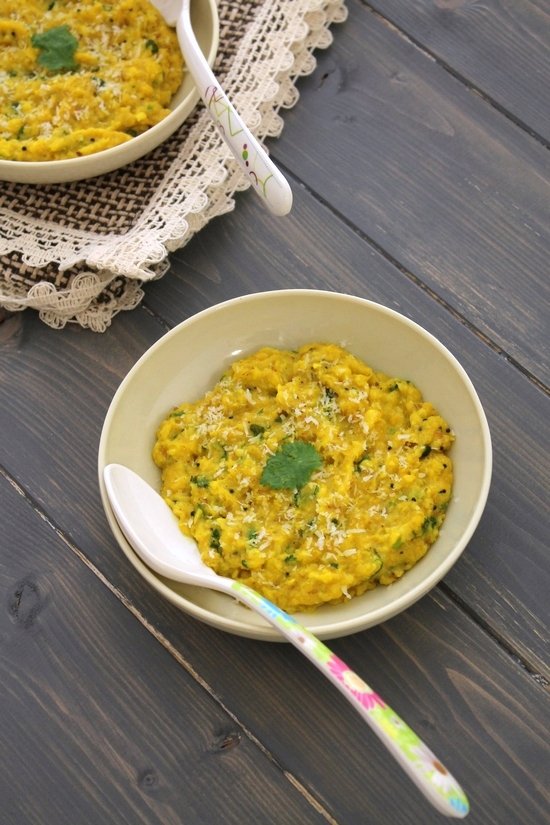
Don’t be confused by the name chevdo—this version isn’t the dry snack mix like cornflakes chivda or poha chevda typically enjoyed during Diwali. Instead, it’s a warm, moist preparation made with fresh corn that delivers a comforting blend of flavors. Instead, this is a moist, warm snack brimming with textures and flavors, made with tender kernels of corn.
A Taste of Nostalgia
This Makai No Chevdo recipe holds a special place in my heart—it’s one of those comforting dishes my mom used to prepare during the monsoon season when desi corn was at its peak. Unlike the commonly available American sweet corn, desi makai has a firmer texture and an earthy flavor that adds depth to the dish.
Flavor Profile
Makai No Chevdo strikes a beautiful balance of flavors—mild heat from green chilies, a gentle sweetness, and a hint of tang from fresh lemon juice. It’s not overwhelmingly spicy; instead, the flavors come together harmoniously with every bite.
Pro Tip: Adjust Sugar and Lemon with Care
One of the most important aspects of getting this dish just right is nailing the balance between sweet and tangy. And here’s the trick—there’s no fixed amount. It all depends on the natural sweetness of the corn you’re using.
For instance, if you’re using sweet corn (like I did), you’ll likely need less sugar. On the other hand, desi corn may require a touch more. Always start with a small amount of sugar and lemon juice, taste, and adjust gradually.
The Secret Ingredients: Coconut and Sesame
What elevates this dish from simple to sensational is the addition of grated coconut and roasted sesame seeds. These two ingredients infuse the chevdo with a delicate nuttiness and a subtle crunch, making it even more enjoyable.
Ingredients For Makai No Chevdo:
- 2 medium-sized desi corn cobs or 1 cup sweet corn kernels: Grate or coarsely grind the kernels. If using frozen corn, thaw and pulse in a mixer without adding water.
- ¾ cup whole milk: Helps to cook the corn while adding a mild creaminess to the dish.
- 1½ to 2 tablespoons oil: Use any neutral-flavored oil for sautéing the spices and aromatics.
- ¼ teaspoon mustard seeds (rai): When sizzled in hot oil, they release a distinctive nutty aroma, creating the flavorful foundation typical of many Gujarati dishes.
- 1 dried red chili: Infuses the dish with a gentle smoky heat; break it into pieces for a spicier kick or keep it whole for a milder flavor.
- ¼ inch piece of cinnamon stick: Infuses the dish with a gentle warmth and mildly sweet, woody aroma that enhances the overall flavor profile.
- 2 whole cloves (laung): Adds depth and a slightly sweet-spicy flavor.
- 1 teaspoon white sesame seeds (til): Lends a delicate crunch and a toasty, nutty flavor that adds depth and texture to the dish when sautéed.
- One teaspoon ginger paste or freshly grated ginger: Brings a warm, zesty flavor that pairs well with corn.
- 1 green chili, finely chopped: Adds a fresh, sharp heat to the dish—feel free to increase or reduce the quantity based on your spice tolerance.
- ¼ teaspoon turmeric powder (haldi): For a touch of earthy flavor and bright yellow color.
- A pinch of hing (asafoetida): Enhances the flavor, especially if skipping garlic or onion.
- Salt to taste: Adjust according to preference.
- ¼ teaspoon garam masala: Brings a finishing touch of warmth and complexity with its blend of fragrant spices, rounding out the flavors beautifully.
- ½ to 1 teaspoon sugar: Adjust depending on the sweetness of your corn.
- ½ to 1 teaspoon lemon juice: For brightness and tang, add gradually and taste as you go.
- 1 tablespoon desiccated or freshly grated coconut: Adds natural sweetness and a soft bite.
- 2 tablespoons fresh coriander leaves, finely chopped: For freshness and garnish.
Step-by-Step Instructions:
1) If you’re working with fresh corn on the cob—whether it’s traditional desi makai or sweet corn—you can grate it straight off the cob using a box grater for a fine, textured consistency. Alternatively, you can slice off the kernels and pulse them coarsely in a mixer grinder or food processor. The goal is to break them down without turning them into a smooth paste, preserving a bit of texture for the final dish. If you’re using frozen corn kernels, allow them to thaw completely, then pulse coarsely—avoid grinding them into a smooth paste. Transfer the grated or ground corn, along with any natural juices, into a pressure cooker.
2) Add ¾ cup of milk to the corn mixture in the cooker. This helps cook the corn while giving it a rich, creamy texture.
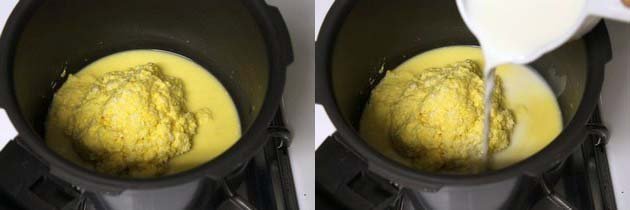
3) Mix the contents gently. Close the lid of the pressure cooker, place the weight (whistle) on top, and set the heat to medium. Allow the mixture to cook for 2 whistles.
4) Once the cooking time is over, turn off the flame and allow the pressure to drop naturally on its own. Avoid opening the lid prematurely, as this resting time helps the corn mixture finish cooking evenly and absorb the flavors. When the lid opens, you’ll see that most of the milk has been absorbed, and the mixture has thickened. Set this aside for the final step.
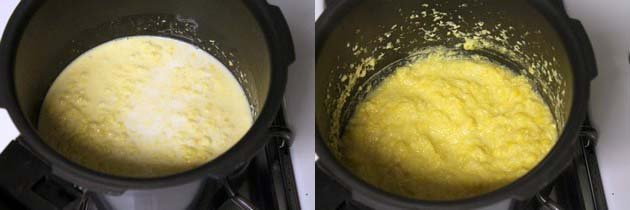
5) While the corn is pressure cooking and releasing pressure, prepare all your tempering ingredients. Since the cooking process moves quickly once the tempering begins, it’s best to have everything chopped, measured, and ready to go. Heat oil in a wide, heavy-bottomed pan over medium heat. Once the oil is hot, add mustard seeds and let them crackle and pop.
6) Next, toss in the dried red chili, a small piece of cinnamon stick, and the cloves. Let them sizzle in the hot oil for a few seconds, releasing their warm and aromatic flavors into the tempering. Sauté for about a minute until aromatic.

7) Add the sesame seeds. Stir and let them toast lightly—they will begin to pop slightly.
8) Add the ginger paste and finely chopped green chili. Sauté this mixture for 30 to 40 seconds until the raw aroma fades.
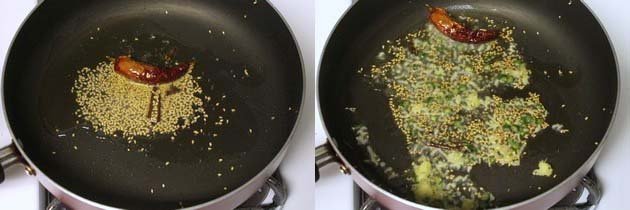
9) Sprinkle in the turmeric powder and a pinch of hing (asafoetida). This adds both color and a subtle depth of flavor.
10) Give it a quick stir to combine the spices with the oil.
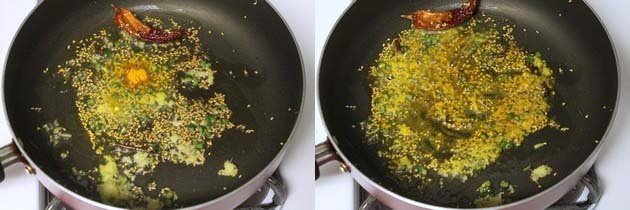
11) Immediately add the cooked and crushed corn mixture to the pan.
12) Stir everything together well and continue cooking the mixture over medium heat. Keep stirring constantly to avoid sticking or burning. The chevdo will begin to thicken further as it cooks.
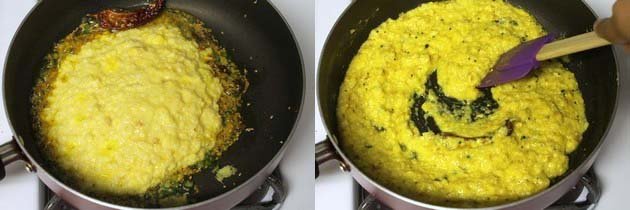
13) This process doesn’t take long—just 2–3 minutes. Stay by the stove and stir continuously; this dish needs your attention at this stage.
14) Once thickened, season the chevdo by adding salt to taste, garam masala, and a small amount of sugar. Stir to incorporate.
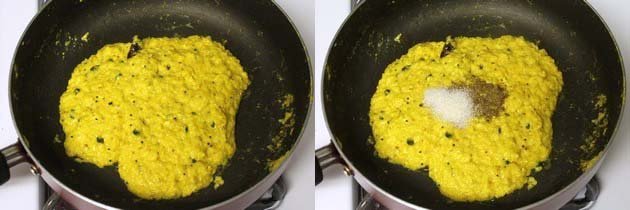
15) Add lemon juice for tanginess. Start with a little and adjust after tasting.
16) Mix everything thoroughly and taste-test the chevdo. Depending on the natural sweetness of the corn, you might need to tweak the sugar or lemon juice, so always start with a smaller quantity and adjust as needed.

17) Once you’re happy with the taste, turn off the heat. To finish, stir in the grated coconut—either fresh or desiccated—for a hint of natural sweetness, followed by freshly chopped coriander leaves to add a burst of color and freshness to the dish.
18) Combine everything with a gentle stir, allowing the flavors to blend beautifully. Your aromatic, comforting Makai no Chevdo is now ready to be served hot and enjoyed!

Expert Tips for Perfect Makai no Chevdo
- Choose the Right Corn: Desi corn (makai) has a slightly firmer texture and earthy flavor, which works beautifully in this dish. If using sweet corn, reduce the sugar, as it’s naturally sweeter.
- Texture Matters: Whether grating or grinding the corn, don’t over-process it. A coarse texture gives body and bite to the chevdo, while a smooth paste can make it mushy.
- Milk Adds Creaminess: Cooking the corn with milk helps soften it and adds a rich, creamy base. Full-fat milk gives the best results.
- Adjust Sweetness and Tang: Always taste and adjust sugar and lemon juice at the end. The quantity will vary depending on the type and sweetness of corn used.
- Don’t Skip Stirring: Once you add the cooked corn to the tempering, stir constantly to prevent it from sticking or forming lumps.
- Fresh Coconut for Flavor: While desiccated coconut works, using freshly grated coconut elevates the flavor and texture, making the dish more aromatic and authentic.
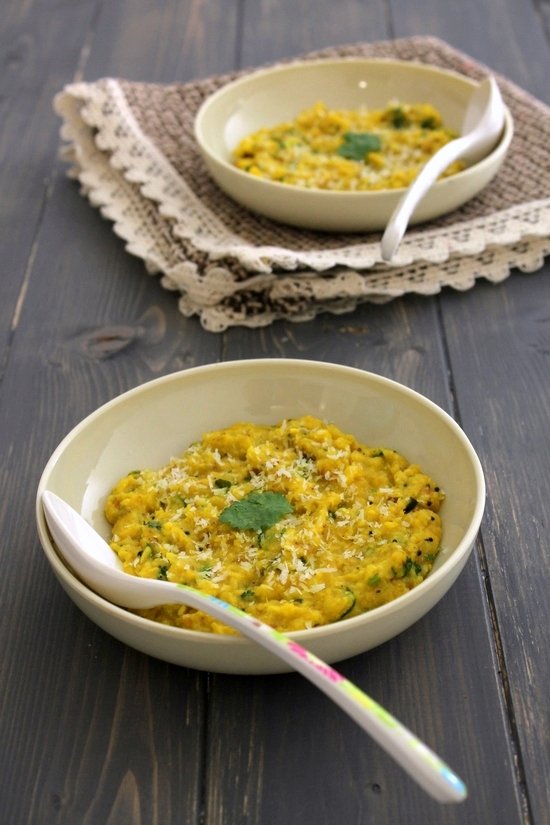
Serving Suggestions For Makai No Chevdo:
- Serve Warm for Best Taste: Makai no Chevdo is most enjoyable when served hot, straight from the pan, as the flavors are fresh and the texture perfectly soft and comforting.
- The flavors are most vibrant, and the texture is perfectly moist.
- Pair it with Tea: Enjoy it as a cozy evening snack with a cup of hot masala chai, especially during monsoon or winter.
- Light Lunch Option: It can also be served as a light, comforting meal for breakfast or brunch, paired with a bowl of plain yogurt or a cup of buttermilk (chaas).
- Garnish Ideas: Top with extra-grated coconut, a few pomegranate pearls, or sev for added crunch and presentation.
